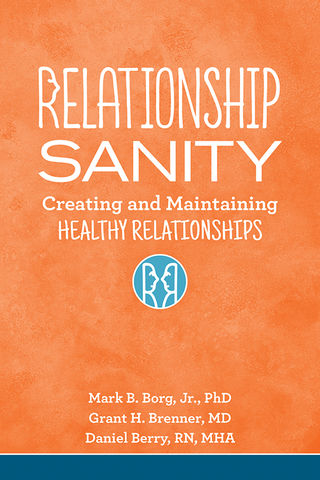Relationships
Relationship Sanity
The Book Brigade talks to the pioneering Irrelationship psychotherapists
Posted October 18, 2018

Our lives are embedded in relationships. Often enough, we find ourselves struggling with the very people to whom we are most connected. How to navigate relationships safely and lovingly?
Your title, Relationship Sanity, implies that there is a lot of relationship insanity.
Insanity can be seen in every type of relationship: intimate relationships (romantic and not), friendships, workplace connections; and, of course, in our national life as well as on the world stage. The unnamed scourge underlying this, which we have called irrelationship, stems from our not knowing how—our never having learned how—to take care of ourselves and one another.
Put simply, insane relationships are relationships that have not achieved balance in giving and receiving, and, therefore cannot give its participants feelings of safety and of loving and being loved. So, yes, relationship insanity is epidemic. Most of us—perhaps all of us—have had painful experiences that taught us to fear opening ourselves up to others for fear of rejection and abandonment. But by actively, though unconsciously, protecting ourselves from such vulnerability, we also wall ourselves off from the possibility of experiencing intimacy, empathy, and emotional investments in others.
Perhaps the principal mechanism by which we do this is by refusing to accept what others offer to us. This creates one-directional but missed connections that generate resentment in the would-be giver and, ironically, feelings of being devalued in the receiver, whose needs go unmet. Lacking the feelings of safety and the skills required for disclosing and discussing candidly their own needs and to how they would like to have those needs met, the parties are left feeling increasingly isolated and frustrated and unable to figure out why.
Why did you write Relationship Sanity?
Writing both Relationship Sanity and our earlier book, Irrelationship, grew out of, first, the experience of trying to understand our own relationships; and, second, the desire to share with others—clients, friends, colleagues—why intimacy was such a problem for us, and how we got to the bottom of the problem and reframed it. The answer lies in nothing more complicated than self-disclosure—startlingly simple—and, for many, equally frightening. But the book teaches readers a pragmatic, absolutely hands-on approach to moving beyond self-constructed obstacles to intimacy and into an ongoing, every-day— and we mean every day—process of building satisfying relationships.
Many people understand how interactive patterns dating from childhood can interfere with forming adult relationships. But having that insight isn’t enough: When we hit a wall in our relationships - perhaps the same wall, again and again - we’re naturally going to ask, “Why is this happening--again? And how do I fix it?” Just being able to identify that “something’s up” (which the book calls the Discovery phase) is flipping the first domino. But this book doesn’t just leave you with a great explanation of what’s been wrong--in this case, how and why you’ve been keeping intimacy at a distance: We take you through a process of jointly taking apart the feelings underlying that distancing, but doing it with someone you care about, while, at the same time, learning to put something genuine and unexpectedly thrilling in its place. That “something” is what we call relationship sanity.
The insight and impetus for our formulating our ideas around relationship sanity emerged as the three of us discussed what we view as an epidemic of “compulsive caregiving” that interferes with reciprocity and closeness in all types of relationships; hence the title of the first book, Irrelationship: How We Use Dysfunctional Relationships to Hide from Intimacy. The response our ideas repeatedly validated our own relationship experiences but underscored the need for a new book that charts concretely a way out of irrelationship and into, well, relationship sanity.
What kinds of relationship phenomena strike you as most insane?
That’s easy: The most insane and most pervasive phenomenon driving our work is the delusion of self-sufficiency. As soon as any of us start telling ourselves that we’re self-sufficient (or ought to be) we begin losing track of our need to be both loving and lovable—both of which are vital to our survival as healthy human beings. Obviously, this is insane. On the other hand, a conscious awareness of how thoroughly we rely on one another is likely to be anxiety-provoking because it exposes our vulnerability to each other—not exactly the most popular theme in our culture. Nevertheless, constructing any relationship—including our relationship with ourselves—to distance us from the idea of this dependency is both crazy and crazy-making.
Your previous book, Irrelationship, explained how fear of intimacy leads people into dysfunctional relationships. How does this book carry the theme forward?
Relationship sanity as we describe it is the antidote to irrelationship. In the new book, a review of the genesis and imbalance of irrelationship is used as a set-up for a detailed description of the DREAM Sequence. The DREAM sequence is the technique for naming the “whys” and “hows” of irrelationship and for jointly building relationship sanity as both practice and goal of shared lives. Additionally, we draw out the usefulness of this technique not just for intimate couples, but in virtually any interpersonal context by practicing what we call “self-other help.”
What is real intimacy and why are people so scared of it?
Intimacy is the process of getting to know someone through self-disclosure and mutual discovery, which occurs in the process of simply living our lives with that person—in short, of learning from one another who they, and we, really are. This goes beyond the chemistry and intensity of passion—though passion may certainly be an aspect of this process. Intimacy so understood is more profound than the supposed self-disclosure of telling one’s secrets because it reveals to one another who we are and what it’s like to live with us in the everyday, and to accept each other as such unconditionally. And of course this is frightening: We’re allowing someone else to see even things we don’t like about virtually every aspect of ourselves—a terrible gamble to take, but one that intimacy requires
Are all couples unhappy from one or another of a set of standard problems or is each couple unique in its dysfunctional pattern?
We find similarities among couples whose dysfunction aligns with the continuum between irrelationship and relationship sanity. Readers who sketch out their patterns of relating are likely to find areas of dysfunction, but we’re careful to avoid strict categories since every person’s experience is unique, leading to a unique experiences as couples and, therefore, to constructing unique solutions. The commonality is in the technique of self-disclosure—the practice of relationship sanity—that couples practice jointly as a means of overcoming their anxiety and isolation from one another in order to rediscover why they were drawn to one another in the first place.
Exactly what is relationship sanity?
Relationship sanity is both the goal and the practice of loving and allowing oneself to be loved - of being open to learning what my partner really feels and needs, and of my being open to revealing to my partner what I feel and need and allowing her or him to meet me there.
How does one get there?
The assessment tool for "getting there" - the actual organ of self-other help - is the 40-20-40. This tool empowers users to navigate conflict constructively by creating a safe space for achieving resolution through mutual, unconditional acceptance, rather than by figuring out who’s right and who’s wrong. In the 40-20-40, persons involved in conflict take turns sharing their own perceptions and feelings without placing blame or taking their partner’s inventory. By committing to using the 40-20-40, couples can effectively address and resolve or approach resolution to any conflict situation, from arguments over household chores to domestic violence to infidelity.
What are the early signs that a relationship is going off the rails?
Early signs of serious relationship problems can be quiet and subtle. One of the most common is when one or both partners become aware of missing the other. This happens even in couples who have shared the same bed for years. Additionally, they may have a vague sense that something doesn’t “feel right,” though neither can quite say exactly what that means. They may feel unexpected flushes of sadness and tears connected with memories of earlier stages of their relationship that seem inexplicably to have vanished. Also, partners having these experiences will have histories of repeatedly ignoring these feelings because of the sadness or the anxiety accompanying them.
What are the best ways to get a relationship on track?
The first step in rediscovering intimacy that has been lost is admitting to the feeling that something is wrong and becoming willing to disclose those feelings to someone else. This first “someone” may not be your partner; but saying it out loud to yourself and then to another person is a huge step. The door to recovery from irrelationship will open further as you become able to reveal your unease to your partner, whose own unease will begin to be relieved when she or he realizes they’re not alone in feeling the uncomfortability in your relationship. If you begin to use the 40-20-40, the process of getting your relationship back on track will begin to take on a life of its own.
What do you think is the most important skill or trait to deploy in a relationship?
The most important skill to be cultivated in any relationship is is the willingness and ability to listen to and accept your partner unconditionally, exactly as she or he is and accept what they bring to the table--for better or for worse. Practicing this type of hospitality of the heart is necessary for the growth of mutual love and genuine intimacy.
If you could tell only one thing to someone about relationships, what would it be?
The most vital piece of the reciprocity that allows relationships to flourish is telling your partner the truth about your feelings of vulnerability. This opens the door to experiencing loving and being loved as you really are.
About THE AUTHOR SPEAKS: Selected authors, in their own words, reveal the story behind the story. Authors are featured thanks to promotional placement by their publishing houses.
To purchase this book, visit:





